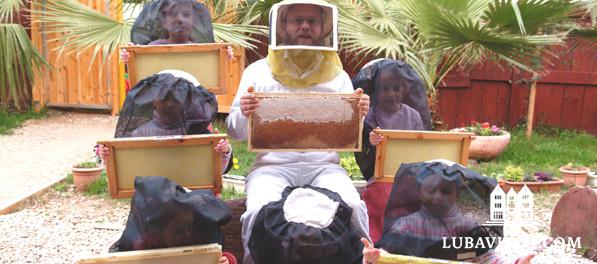(lubavitch.com) On a recent field trip with south Tel Aviv’s Camp Neve Eliezer, eighty children, all clad in shorts, sandals, and matching baseball caps, clapped and laughed at the antics of “Itchele,” a character in a multi-media presentation who suffers deeply from hay-fever. His grandmother, a puppet named Rachel, is looking for him so she can give him honey cake; honey, she says, has healing properties. A film shows Itchele running through a honey farm, about to open a hive bare-handed.
“Nooooooo!” scream the children.
Itchele takes the children’s advice and proceeds, along with a woman dressed as a worker bee, to teach the audience about the life and industry of a bee hive.
The weeks leading up to Rosh Hashanah are the busiest time of year for this bee park in Kfar Chabad, the village outside of Tel Aviv, just a few kilometers distance from Ben Gurion Airport.
M’Achoray Hadvash (Behind the Honey), as the attraction is named, draws camps and schools searching for educational destinations that fit with the theme of the fall Jewish holidays, including Rosh Hashanah. Of the 3,000 tons (or more) of honey purchased in Israel every year, 40 percent is consumed during the September and October holidays as Jews seek to “sweeten” the New Year. The tradition of eating apples dipped in honey dates from the late medieval period.
According to information provided by the Israel Honey Council, Israel’s 500 honey farmers maintain 90,000 hives, producing 8 million pounds of the sticky sweet stuff. Even this is not enough to quench the Israeli sweet tooth. In recent years, lack of rainwater has affected the avocado, citrus, and other crops on which beekeepers rely for pollen, and honey production has decreased by almost 25%. So, ironically, the Land of Milk and Honey imported 1,300 tons of honey in 2008, up from 940 tons the year before.
Beekeepers also face stiff competition from producers of artificial honey, and sporadic theft of hives by Arabs. Still, according to the Central Bureau of Statistics, the apiaries are injecting over $10 million of consumer goods into the Israeli economy each year.
The idea for M’Achoray Hadvash started with Rabbi Moshe Scheerson, a Jerusalem native, teacher, school principal and father of 20 who was encouraged by the Lubavitcher Rebbe, Rabbi Menachem M. Schneerson, of blessed memory, in the 1950’s to turn to farming in order to better support his family. Along with turkeys and vegetab les, Moshe Schneerson grew his honey business in Kfar Chabad to 300 hives. Meanwhile, the teacher in him wished to expose local children –and his own family — to the harmonious life of the honey bee.
“Taking care of bees is very calming,” said Moshe’s son-in-law, Shlomo Rivkin, who studied apiary crafts under his Moshe’s tutelage. “People think they are temperamental, but actually in nature they are very calm. They do their work, helping each other. He wanted children to see that.” Moshe installed three glass hives on the third floor of his home and gave presentations to neighbors, but lacked the time to develop a true curriculum.
But his son, Levi Schneerson, eventually inherited Moshe’s honey interest, and has since grown the farm to 900 hives. Another son opened a store in Kfar Chabad in which he sells honey products.
It was a daughter, Shoshana (Shoshi) – the tenth of Moshe’s twenty children— who in 1994 embarked on a project with her husband, Shlomo, to expand her father’s idea for an educational program about bees and honey farming. Today, between 10-15 thousand children each year – most from secular schools and camps – participate in workshops in making candles out of beeswax; games in which visitors re-enact life in a hive, such as collecting pollen, cleaning, and building wax; relay races to spin frames and find the Queen bee in a live hive; and a presentation run by Shlomo, in which he shows the children an actual hive. (Upon being shown a frame covered in wriggling bees, choruses of “oy” and “oog” rose up from the Neve Eliezer campers.)
Jewish values are woven into the program when possible. The multi-media presentation, in particular, includes messages about appreciating God’s gifts and the wonders of nature. “How great is Your works, O G-d,” Itchele sings, quoting a verse well-known to Israelis, before pulling four little boys into the performance area to dance with him in a circle, Chasidic-style. But the actors are light-handed in delivering religious messages; most of the program focuses on bees themselves. “That was so funny” exclaims an 8-year-old girl on her way out of the multi-media presentation.
“It’s one of the best activities we’ve had,” said the Neve Eliezer camp director, who introduced herself only as Shir. “We want to do something educational, not just fun. They gain knowledge here, learn about something interesting in the world.”
The children go home with certificates for finishing the M’Achoray Hadvash beekeeping program, group photos, and their beeswax candles.
Moshe Schneerson did not live to see the full blown bee-park. But his children are gratified.
“My father would have been very pleased with what we are doing here,” Shoshi said. “It keeps growing and growing, thank G-d.”

Be the first to write a comment.